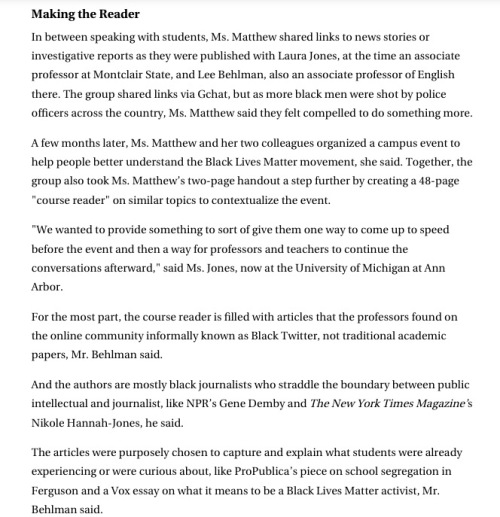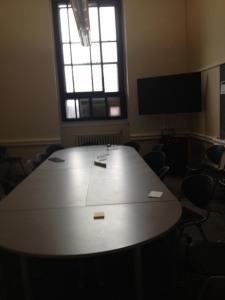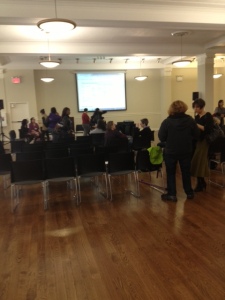It’s evaluation time and students have the chance to offer anonymous feedback about their experience in the classroom. As a tenured faculty member, I’m not required to undergo this process, but from time to time I do so anyway. Even when I don’t arrange for university evaluations, I ask my students for feedback about the semester. It’s always a bit unnerving, and I can never quite shake the feeling that it feeds into the consumerism mode of higher education, but I believe it can be a useful process. This year, as I’ve been thinking of what it means to be a professor of color in the academy for a solid decade, I’m thinking of the daily informal assessments that happen all the time, and I’m remembering the time I told a graduate student to take a seat.
Literally.
I’ll never know exactly what pushed this particular graduate student to stand up in the middle of my Research Methods course and shout, “You can’t lecture me!” He’d been terse and combative from the first day of the term, but it’s been so many years (easily seven or eight) that I’ve even forgotten what we were talking about when he forgot himself. It’s possible that he was angry that I hadn’t paid enough attention to Byron’s use of ottava rima in Don Juan (no, I’m not kidding). I remember being amused when he wanted to know if I knew this pertinent fact about the poem (of course, I did). And when he wanted to explain to me that feminism was a crock because men were responsible for good things like the Sistine Chapel, I remember trying to gently but firmly move the conversation towards more productive ground. I also remember feeling some genuine sympathy for him. Here he was, forced to take a course that was not of his choosing with an instructor he might not ever have chosen to study with. All graduate students in our program must take Research Methods, it’s only offered once a year, and, at the time, I was the only instructor teaching it. He was white and his privilege expressed itself with a stridency I could tell made his classmates uncomfortable. He wasn’t the first student with this habit, but he was the most aggressive.
I don’t remember why this student stood up in a room of about twenty students and yelled “you can’t lecture me!” but I do remember that, in the moment, my gallows humor crowded everything else out; in reply I said, dryly, “well, actually, that’s my job. Literally. I mean it’s in my contract and everything.” I then told him he could either sit down or leave the class. He chose the latter. I don’t remember the rest of the class discussion, but I remember being surprised by how unfazed we all were by the moment. It wasn’t until after class, when two other male students (both of whom were white) offered to walk me to my car in case he was still hanging around that I started sorting through the implications of the moment. I was very new to my department, I was untenured, and I had been asked to restructure the Methods course and made some fairly radical changes to it. I knew I was going to have to explain what happened to both the Graduate Director and the Department Chair, both of whom were white and male.
For those who pay attention to what it means to be a person of color in today’s university system, the common narrative is that we face more service pressures than our white colleagues. We’re called on more often to work with student groups, to diversify committees with our very presence, to do the administrative work of turning ethnic studies classes into programs and programs into departments. These are duties many choose to take on and the savviest parlay that into currency to count towards tenure and promotion. But the disrespect, disdain, and rage we regularly deflect in the classroom bring on a different kind of pressure entirely. If we are the marginalized “other” in departments, balancing research and teaching agendas with internal and external service pressures, in the classroom we occupy two subject positions at once: Authority and Other. It’s a tricky thing to be on the margins and in the center in the exact same moment. The need to protect one’s authority and humanity while preserving the classroom space as a workshop of ideas where students can stumble, experiment, and question is a balancing act that requires more than good intentions on the part of faculty of color. It requires personal and institutional support. In this situation, I was lucky enough to have both.
This moment, this shout is at the most extreme end of the continuum of students behaving badly, but I’ve seen some version of it over my ten years as a university professor. And I know my experience is not singular. In fact, as someone who specializes in the very safe field of nineteenth-century British literature, I suspect I’m having a much easier time of it. Even this semester’s Austen lecture titled “Post-Colonial Theory and Mansfield Park; or is Fanny Price Actually a Sister?” sparked more interest than anger in my Austen seminar, and my students were totally up for the metaphors of race in the novel. They were intellectually skeptical to be sure (that’s what they’re supposed to be) but certainly engaged in the debate. If I taught race in a more modern context as I did in my intro to theory class this year, I’m sure there would be more shouting. I’m sure I’d face more moments like Professor Shannon Gibney is currently facing.
The professor received a formal reprimand:
The reprimand was due to the discomfort of two white male students who said they were being personally attacked while Professor Gibney led a discussion about structural racism in her political science and communications course. These very students interrupted Professor Gibney during the discussion, expressing that it was upsetting to them that it was being discussed at all. MCTC went so far as to identify Professor Gibney’s conduct in the class as a violation of the Non-Discrimination Policy and she was directed to meet twice with the Chief Diversity Officer to learn how to be more welcoming to people of all backgrounds.
Deborah J. Merritt’s “Bias, the Brain, and Student Evaluations of Teaching” begins with this from When Sapphire Meets Socrates at the Intersection of Race, Gender, and Authority:
The complaints are never-ending, voluminous, and contradictory. I talk too loud or not loud enough. I walk too close to people and make them nervous. If I look at students, they are nervous. If I do not look at them, I am picking on them. If I do not call on them, I have a personal vendetta against them…
The black female professor continues:
When I talk to students in an attempt to ascertain what I do that is so different from the other professors teaching the same section of first-year students, they admit that I do no more in class than their white male professors—my class is no more rigorous, no more intimidating, no more work. In fact, they seem to like my class.
Merritt’s essay (which you should read in its entirety) shows that:
The nonverbal mannerisms that drive teaching evaluations bear little relation to learning. Many of the nonverbal behaviors that influence teaching evaluations are related to race, gender, and other immutable characteristics; they stem from physiology, culture and habit. Social stereotypes filter perceptions of these behaviors so that even when faculty engage in identical classroom behaviors, students may perceive those behaviors differently depending on the professor’s race, gender, and other characteristics.
On a larger scale, this seems key to understanding the limits of teaching evaluations in general and specifically how they are used when faculty of color are evaluated. Put simply, student evaluations can be just another form of shouting at professors of color, particularly women of color.
Consider these findings compiled by Therese Huston in her research report “Race and Gender Bias in Student Evaluations of Teaching”:
• Researchers found lower final course evaluation ratings for female minority faculty members, but not for male minority instructors
• Hispanic faculty received the lowest course evaluation ratings. Asian-American faculty receive slight (sic) better course evaluations than their Hispanic colleagues, but their scores were, on average, still worse than the scores of White Faculty.
• Students rate Asian-Americans instructors as less credible and intelligible than white instructors.
• Male non-native speakers received lower evaluations than female non-native speakers.
• Women received lower evaluations than men and faculty of color were judged more harshly than their white counterparts
• When Whites rate the performance of a person of color with the understanding that their judgments would be communicated to a third party for the purposes of evaluation, Whites consistently rate performance negatively
There’s more that I’m sorting through here, especially how students evaluate faculty teaching ethnic studies vs. those teaching in other fields. If others have more recent studies or narratives, I’m happy to read them, but the larger question perhaps is not just that this is happening but what we can all do about it.
In my first post, I offered advice (a script almost) of how white colleagues can support faculty of color in this particular area. My advice was rooted in my own experiences in my current department.
Generally speaking, my colleagues, whether I am with friends with them or not, belong to the “If You See Something Say Something” school of witnessing microaggression. If a colleague in my department witnesses someone treating me poorly because I’m a person of color, they say something and then follow-up with an e-mail or stop by my office to make sure I’m okay. If I share something that happens to me (the shout, pissing someone off because I’ve had to point out, yet again, that I’m not a secretary, hearing that vocal students think I’m a bitch, being told I’m hostile and so on), I’m met with compassion and a genuine attempt to understand what I’m processing. Ten years out, I’ve come to appreciate this and count on it, but when I was new I had no idea what kind of environment I was in and felt I had to defend myself to the Director of Graduate Studies and my Department Chair. I was not looking forward to talking to anyone about what had happened, never mind two white men—no matter how congenial they’d been.
The Director of Graduate Studies called me at home, and his first question was about whether or not I was okay. He then asked what I wanted to do about the student. It was such a simple, collegial gesture. This student had challenged my authority, and, though I had handled it well, I was shaken and worried about how I would save the rest of the term and my reputation with my students and colleagues. His first question about my well-being calmed me immediately, and his second questioned helped me get back on my pedagogical feet (I had no interest in “punishing” the student but didn’t want him disrupting my class). The conversation had gone so well that I was beginning to relax. Then my Chair sent an email that same evening asking me to drop by his office in the morning.
He’s not a loquacious man, and I was a bit intimidated by him. I would come to see him as Lou Grant to my Mary Richards, but after that shout we weren’t there yet. I believed we would come to some understanding about the situation (he struck me as fair), but I was not looking forward to the process. I went in ready to explain myself, to give him “my side” of the story.
He didn’t need it.
He wanted to know if I was okay. More than that, he wanted me to know that he’d had an experience similar to mine with another student and that he could imagine how awful it felt. His point wasn’t to diminish what had happened to me but to let me know I wasn’t alone, that even old pros, with all of the privileges of masculinity and whiteness got kicked around by students from time to time. And that it felt like shit when it happened. That last part was most the most important part. Too often, when marginalized people talk about their struggles, members from dominant communities rush in to point out that the experience is not unique so marginalized people (women, people of color, GLBT citizens, and so on) should just shut up and deal. The better approach, the one rooted in empathy, is the one from my Chair—it made us both human without diminishing my particular challenges as a woman of color. It also taught me to share my troubling or confusing interactions with students with colleagues I trust. They helped me understand the culture of my institution so that I could better respond to what happened in my classroom, to know what was just “normal” and what was deeply problematic.
My students in that Research Methods course were equally generous. I explained that the student wouldn’t be returning to class not because he had questions about feminism (or Byron) but because the classroom space needed to be as free from distracting chaos as possible. They were happy with my explanation and then went out of their way to tell me that he was aggressive in every single class. I was surprised by this fact, but ten years out I wouldn’t be. It’s been my experience that students who struggle with having a black, female professor struggle in other ways. Race in the classroom, whether it’s embodied in the instructor or represented on the syllabus, simply amplifies bad behavior. This is cold comfort (I’ll never get used to what my presence as a woman of color in the classroom can trigger in students…never), but the context helps me keep an important balance so that I can manage the many forms that shouts can take without disrupting my classroom.




